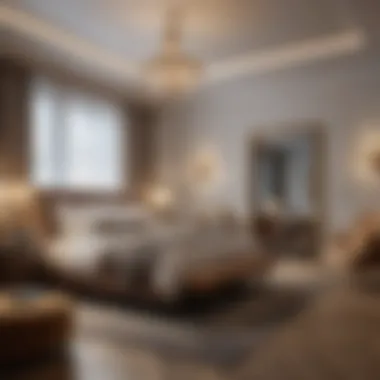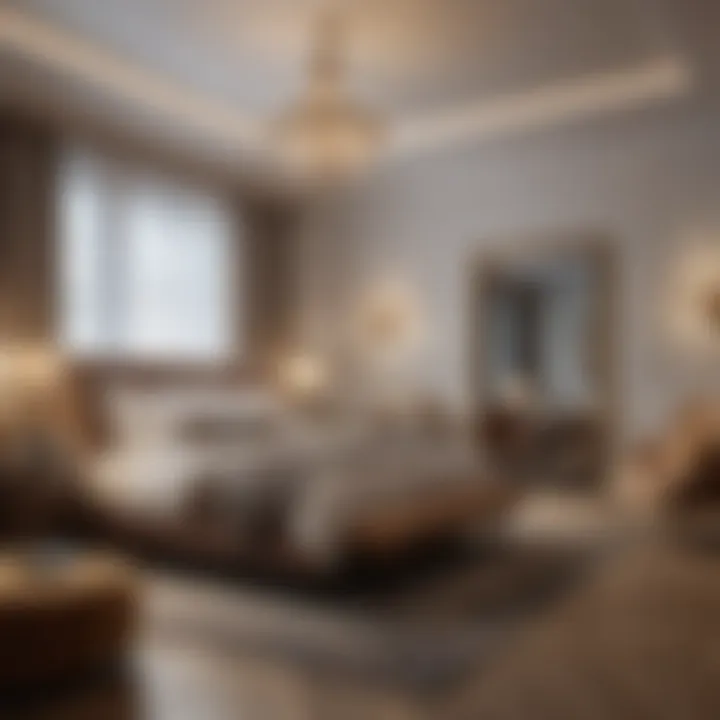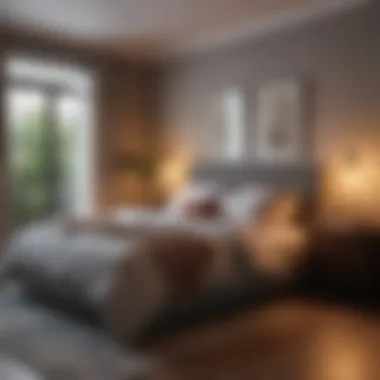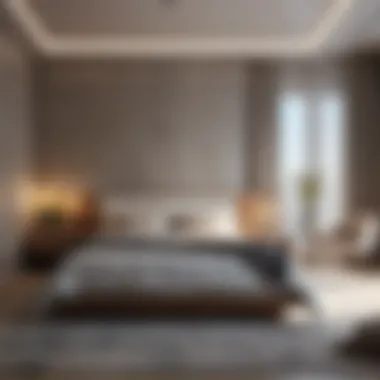Redesign Your Bedroom: Practical Tips for Transformation


Intro
The bedroom often stands as the cornerstone of our daily lives, a personal retreat where the chaos of the outside world fades away. Redesigning this space is not just about aesthetics; it’s about crafting a sanctuary that reflects who you are and supports your well-being. As we embark on this journey of transformation, it’s crucial to pay attention to both the visual appeal and the functional layout. Each choice, from color to furniture arrangement, can profoundly influence how we feel in our surroundings.
Rather than merely slapping a coat of paint on the walls or rearranging furniture, this guide invites you to delve deeper. Think of it as piecing together a puzzle that will all come together to create not just a room, but an experience. With practical insights tailored for busy housewives and homeowners, let's unlock the secrets to a bedroom that’s pleasing to the eye while enhancing your comfort and lifestyle.
Current Trends
Color Palettes
Choosing the right color palette can set the entire tone of your space. Whether you lean towards soothing neutrals or bolder hues, colors play a significant role in how the bedroom feels and functions.
Trending Color Schemes:
- Soft Pastels: These colors, like blush pink or baby blue, offer a sense of calm and serenity.
- Earthy Tones: Shades like terracotta and olive green create warmth and connection to nature.
- Monochromatic Schemes: Combining varying tints of one color can establish elegance without overwhelming the senses.
Popular Styles
Familiarizing yourself with the latest design styles can help breathe fresh air into your bedroom. Here are several that have captured attention recently:
- Minimalist: Focuses on simplicity, featuring clean lines and functional furniture while avoiding clutter.
- Bohemian: Mixes vibrant patterns and textures, often incorporating plants for a touch of life and creativity.
- Scandinavian: Renowned for its functionality and light, airy feel, this style marries comfort with a sleek aesthetic.
These trends represent just a slice of what’s possible. As you consider your options, think about how these styles align with your personality and lifestyle.
Visual Ideas
Gallery of Styled Bedrooms
Visual inspiration holds immense power when it comes to redesigning your bedroom. Utilize platforms like Pinterest or Instagram to gather ideas and see how various elements work together in real-life settings. Here are some key styles you should search for:
- Cozy reading nooks integrated into bedrooms.
- Luxurious bedding arrangements that invite relaxation.
- Unique headboard designs that become the focal point of the room.
Before-and-After Transformations
Nothing illustrates potential quite like a transformation showing a bedroom's journey from drab to fab. This can serve as a motivating factor in your redesign. Start imagining:
- A dated space with mismatched furniture, brightened by cohesive elements and a fresh coat of paint.
- Heavy curtains replaced with light, airy drapes that allow natural light to flood the space.
"Transformations often start with a vision. Envision the space you desire, and let creativity guide you toward achieving it."
The succinct combination of planning, visual stimulation, and bold choices will help you redesign your bedroom in a way that speaks directly to your soul. As we continue this journey, each piece of advice will lead to a more tailored and gratifying final result.
Understanding Your Current Space
Before diving into the sea of possibilities for redesigning your bedroom, it’s crucial to take a step back and understand your current space. This initial assessment sets the stage for any transformation, guiding design choices that align with your needs and preferences while maximizing the potential of the room. By evaluating your space, you can create a foundation that not only enhances aesthetic appeal but also boosts functionality.
Evaluating Size and Layout
Start by measuring the dimensions of your bedroom. This includes not just the overall square footage, but also the height of the ceilings and the placement of doors and windows. Imagine you have a small, cozy room that feels cramped. An accurate measurement will lead you to the realization that certain bulky furniture pieces may need to be swapped for slimmer, more streamlined alternatives. Getting a ruler out or using a measuring tape is not just a chore; it’s an investment in future comfort.
Next, consider the layout. Arrange your furniture virtually before moving it around physically. Visualize how traffic flows through the space. This can prevent future regrets. If the bed blocks the window or makes it difficult to access your closet, it might be time to rethink the setup. A simple layout down on paper can unveil brilliant ideas, even if you’re no Picasso. Take note of how each piece interacts, making adjustments as necessary. This will help create a more open, inviting atmosphere.
Identifying Strengths and Weaknesses
After evaluating size and layout, shine a light on both the strengths and weaknesses of your space. Acknowledge what works well, even if it’s just a huge window that lets in the morning sun. This can be an anchor point for your redesign. Perhaps you love the high ceilings or a quirky alcove. Knowing these strengths allows you to play them up in your design.
On the flip side, it’s equally vital to address weaknesses. Is that carpet more stained than it should be? Or does the dark paint make the room feel smaller? Identifying these pain points can ultimately lead you to better solutions. List out these issues, and be realistic. Sometimes, accepting certain constraints, like the room’s odd shape, can inspire creative solutions that lead to a charming design rather than a frustrating limitation.
Establishing Goals for Redesign
Establishing clear goals for redesigning your bedroom is like laying the foundation for a house. Without it, you may find yourself lost in an array of choices that can lead to further confusion rather than clarity. Knowing what you want to achieve with your redesign not only directs your efforts but also aids in weaving together aesthetics and practicality. Setting goals allows you to create a space that resonates with your unique personality and lifestyle needs. Moreover, it aids in managing your resources effectively—saving you from splurging on items that don’t quite fit into your vision.
Defining Your Style
Defining your style is where the magic of personalization kicks in. Begin by reflecting on what truly resonates with you. Are you drawn to sleek minimalism, or do rich bohemian textures speak to your soul? An exercise you could try is creating a mood board. Gather images from pinterest.com or magazines that capture the essence of your preferred environment. This visual collage will help you identify common threads and elements that define your aesthetic.
In today’s world, where options are endless, carving out a signature style will keep you grounded. You might find inspiration in nature, art, or even your travels. Consider how light, color, and materials can evoke specific feelings; think of warm earth tones for that cozy vibe or crisp whites for a clean, modern feel. Attaining a coherent aesthetic doesn't just beautify your space; it fosters an atmosphere you genuinely love.
Setting a Budget
Setting a budget is that necessary step that often gets overlooked amidst the excitement of redesigning. It helps in transforming grand ideas into actionable plans. Calculate a realistic budget that reflects your financial situation while accommodating your goals. Remember, being practical doesn’t mean you have to compromise on style. Consider allocating funds to essentials first—like a good mattress or quality curtains—before investing in decorative elements.
Preferences in budget can be highly personal; some folks might find joy in high-end pieces, while others might lean towards thrifty finds. Check online marketplaces like facebook.com or local thrift shops to discover unique decor that won’t break the bank.
Creating a spreadsheet can be a practical tool. List potential expenses and compare costs to identify areas where you can save or splurge. By diving deep into the budgeting process, you create a safety net that helps you avoid future financial strain while transforming your space effectively.
"A goal without a plan is just a wish."
Through establishing goals and setting a budget, you're not just cultivating a bedroom that looks good; you're crafting a retreat that genuinely meets your needs. It ensures that when you walk into your redesigned space, it feels like a harmonious blend of your ambitions and reality.
Incorporating Functional Design Principles
In the journey of redesigning your bedroom, integrating functional design principles holds paramount importance. This step is not simply about aesthetics; rather, it embraces the marriage between style and utility. A well-thought-out functional design enhances your living experience, aligning the space with your day-to-day activities and mirroring your personal rhythms. Imagine waking up in a space that serves your lifestyle and aspirations, rather than merely a room with four walls.
Maximizing Space Utilization
Making the most of your available space can drastically reshape the feel of your bedroom. This doesn’t always mean filling every nook and cranny with stuff. Instead, optimizing the arrangement can transform small, cramped quarters into an open, airy retreat.
Consider the following strategies to maximize space utilization:
- Vertical Storage: Utilizing shelves and bookcases that reach towards the ceiling can draw the eye upward and create an illusion of height in the room.
- Multi-Purpose Furniture: Opt for furniture that does double duty. For example, a bed with built-in drawers or a nightstand that offers storage can save space while keeping essentials handy.
- Decluttering: If it doesn’t serve a purpose or spark joy, consider parting ways with items. This principle of minimalism aids in achieving a clean, organized look.
- Layered Design: Use area rugs, curtains, and furniture to define spaces. For instance, a small rug can create a cozy reading nook in a larger room, offering a delineation without the need for physical barriers.
The goal here is to foster an environment where you feel comfortable and unencumbered. After all, a room that feels cramped can lead to a mind that feels cluttered.
Choosing Appropriate Furniture
Selecting the right furniture is crucial, as it affects both form and function within your redesigned space. It’s not just about choosing stylish pieces but choosing those that enhance comfort and usability.
Some pointers to keep in mind include:


- Scale: Select furniture that fits the proportions of your room. Oversized items can dominate a small space, while petite pieces may get lost in a larger area.
- Quality over Quantity: Invest in well-made furniture that will stand the test of time. It’s better to have fewer high-quality items than a bunch of flimsy furnishings that need frequent replacement.
- Comfort Features: Think about the daily activities you will engage in and choose pieces accordingly. If you enjoy reading in bed, for instance, a bed with a supportive headboard enhances that experience.
- Aesthetic Harmony: Each piece should complement the others in the room. Consider color schemes and textures to create a cohesive look that resonates with your personality.
As a rule of thumb, when furniture feels right, it becomes part of the rhythm of your life rather than an intrusion. Ultimately, thoughtful choices pave the way to a bedroom that invites relaxation and energizes your spirit.
A well-planned bedroom layout not only improves aesthetics but also enhances your quality of life, making every moment spent there more enjoyable.
Color Schemes and Ambiance
When diving into the redesign of a bedroom, the color scheme and overall ambiance play pivotal roles. The colors you choose have the power to influence your mood and can even affect your daily routines. A well-thought-out color palette not only unifies your design but also sets the atmosphere – whether it’s calm and soothing or vibrant and energizing. Thus, understanding how to manipulate these elements becomes essential in crafting your personal sanctuary.
Selecting a Color Palette
Choosing the right color palette isn’t just about picking your favorite hues. Instead, it requires an understanding of how colors interact with one another and with the bedroom’s natural light. Start by considering the bedroom's primary purpose. For instance, if relaxation is the goal, softer shades like pastels, muted blues, or gentle greens can create a serene environment. Conversely, for a more invigorating space, bold reds or energizing yellows might be your go-to.
A good strategy is to use the 60-30-10 rule when selecting your colors. This means:
- 60% of the space should be the dominant color (walls).
- 30% should serve as the secondary color (furniture or large decor).
- 10% is your accent color (decorative pillows or art).
Such a structure aids in creating a balanced look while keeping it interesting.
Consider the lighting as well. A room that receives ample natural light may benefit from cooler tones that remain vibrant throughout the day. Alternatively, rooms with limited sunlight can favor warmer shades that help maintain a cozy feel. Test swatches before committing – paint a small area, observe it at different times during the day, and see how it complements your furniture and other decor elements.
Incorporating Accent Elements
Once you have your main color scheme dialed in, incorporating accent elements becomes the cherry on top. Accent colors can really jazz things up, but they require a bit of finesse. They should harmonize with the dominant colors while introducing a fresh burst of energy into the space.
Think about using vibrant hues for accessories like:
- Throw pillows
- Artwork
- Area rugs
- Curtains
For instance, if your walls are painted a beige shade, a striking cobalt blue pillow or a fiery orange piece of art can become focal points that draw the eye. Moreover, these accents help in reflecting your personal style while allowing flexibility for future changes. If you ever want to refresh your space without going for an overhaul, swapping out these smaller pieces can usher in a new vibe without a hefty price tag.
As you blend your accent elements, be mindful of not overcrowding. The goal is to create a space that feels curated rather than chaotic. As a guiding principle, let one or two accent colors shine through rather than overwhelming the viewer with a multitude of mismatched shades.
"The right color scheme is the backbone of a well-designed bedroom, setting the tone for comfort and relaxation."
The Role of Lighting
Lighting is often the unsung hero in converting a mundane space into something visually enchanting and entirely functional. In a bedroom, it plays a crucial part. Good lighting can not only enhance your room's aesthetic but also contribute to its ambiance and your overall well-being. Without sufficient attention to this element, a beautiful redesign can fall flat, leaving it cold or overly harsh. The balance between natural and artificial light, alongside the strategic use of both, can make all the difference in creating an inviting sanctuary.
Natural Light Considerations
Natural light is a game changer when it comes to bedroom design. It’s like painting with sunlight—its presence can brighten up the mood and bring life into what may otherwise feel dreary. Incorporating natural light into your bedroom doesn’t mean you have to throw open the curtains wide every morning. Instead, think about the layout of your windows. Are they large enough? Are they blocked by trees or buildings? Here are some points to bear in mind:
- Window Placement: If you’re planning a redesign, ensure your window placement allows for maximum daylight during the day. South-facing windows are typically optimal in many regions.
- Reflective Surfaces: Using mirrors or light-colored walls can amplify the capacity of natural light, making the room feel more spacious and airy.
- Dressings and Treatments: Light, sheer curtains can filter light beautifully without making the space feel claustrophobic. Avoid heavy drapes that might dim your room even when open.
Even in the colder months, managing natural light can help keep the room feeling fresh. Pay attention to how the sunlight moves in your space throughout the day; making minor adjustments can lead to significant enhancements.
"Natural light in a bedroom is more than just aesthetics; it’s about creating a refreshing environment that promotes peace and tranquility."
Layering Different Lighting Types
Layering is like the icing on a cake for your bedroom lighting scheme. Just as a well-balanced meal needs more than one flavor, your lighting should provide various layers for different activities and moods. Here’s how to do it:
- Ambient Lighting: This is your room’s main light source, offering a general brightness. Consider ceiling-mounted fixtures or flush mounts that provide even distribution. Aim for warm LED bulbs which create a cozy atmosphere.
- Task Lighting: Think about what activities you engage in. If you read often, a bedside lamp or wall sconces set at the perfect height are vital. Adjustable options can make all the difference, especially if you share the space.
- Accent Lighting: Use this to highlight artwork or architectural features. Floor lamps or even LED strips under shelves can lend character while providing visual interest.
- Smart Options: With advancements in technology, you can install smart bulbs or dimmers that adjust according to the time of day. This flexibility allows you to tailor the atmosphere as needed, whether it’s bright for a morning routine or soft for an evening wind down.
When done right, the interplay of these light types makes your bedroom not just visually appealing but also a versatile space for relaxation, creativity, and rest.
By thoughtfully considering how you incorporate lighting into your redesign, you set the foundation for a room that feels welcoming and unique to your lifestyle.
Sustainable Redesign Practices
In the quest for a more harmonious living space, sustainable redesign practices emerge as a beacon of mindfulness and responsibility. This approach doesn’t just enhance your bedroom aesthetically but also respects the environment, ensuring that your sanctuary mirrors not only your style but your values as well. By integrating sustainability, you foster a space that is both functional and eco-friendly. Let’s delve into the specifics of selecting eco-friendly materials and incorporating sustainable decor into your bedroom.
Selecting Eco-Friendly Materials
When you’re in the throes of redesigning your bedroom, the materials you choose play a pivotal role. Eco-friendly materials—those that minimize environmental impact—offer a myriad of benefits. Think of bamboo, for instance. This grass grows quickly, making it a sustainable resource. When crafted into furniture or flooring, it provides durability alongside a unique aesthetic charm.
Another excellent option is reclaimed wood. Using wood that has had a previous life not only reduces the demand for new lumber but also adds character to your space. Each knot and grain tells a story, infusing warmth and history into your bedroom. Similarly, look for recycled fabrics in your upholstery and bedding. Such textiles often carry a smaller carbon footprint and can come in a wide variety of lovely patterns and colors, proving that eco-friendliness doesn’t have to sacrifice style.
Consider the paints you select as well. Opt for low-VOC (volatile organic compounds) or zero-VOC options. These types of paints not only contribute to cleaner air quality within your space but can also be found in numerous shades and finishes that fit any design concept.
"Choosing sustainable materials is not only an investment in your home but in the future of our planet."
Incorporating Sustainable Decor
Once you’ve laid the groundwork with sustainable materials, the next step is integrating decor that echoes these same values. Start with upcycled or vintage pieces. Not only do they reduce waste, but they often bring a touch of character that mass-produced items simply cannot match. Scouring local flea markets, thrift stores, or even online platforms can yield some stunning finds from bygone eras that slot perfectly into your modern bedroom.
Another strategy is to incorporate living elements into your decor. Plants not only beautify your space, but they also improve air quality and promote a calming atmosphere. Varieties such as snake plants or spider plants are low-maintenance and can thrive in dim light, making them perfect companions for a cozy bedroom.
Additionally, consider using decor items that are ethically sourced. Artisan-crafted goods that support local craftspeople help to create a sense of community in your design. Items like handwoven rugs or handmade lamps can serve as focal points, telling a story that resonates with the ethos of sustainability.
Choosing sustainable decor is more than just a trend; it’s a conscious lifestyle choice. When implemented thoughtfully, these elements can seamlessly align with your design goals and offer a sense of pride in your space while treading lightly on our planet.
Personalized Design Touches
When it comes to redesigning a bedroom, personalized design touches hold a significant role. These elements breathe life into your space, reflecting who you are and what you love. A personalized environment doesn't just feel more like home; it creates an atmosphere where you can unwind and recharge. From selecting the right decor to incorporating elements that tell your story, personalization is what transforms an ordinary bedroom into a sanctuary.
Curating Your Decor
Curating decor is much like assembling a fine piece of art. It requires thoughtfulness and an eye for detail. Begin by considering a cohesive theme that resonates with your personality. Whether it’s bohemian, minimalist, or contemporary, your choice sets the groundwork for every other design decision you’ll make.
- Color Coordination: Think about how colors affect mood. Incorporate hues that evoke feelings of calm or creativity. For example, soft blues might create a serene atmosphere while warmer tones could foster a more vibrant energy.
- Texture and Materials: The materials you choose play a crucial role in the overall vibe. Mixing textures—like smooth linens with cozy knits—adds depth and warmth. Don’t hesitate to experiment; perhaps a faux fur throw over a sleek armchair will introduce a delightful contrast.
- Focal Points: Choose a statement piece as your focal point. It could be an oversized piece of artwork, a unique headboard, or even a vintage dresser that sparks conversations. This will draw the eye and anchor your decor around it.
- Functional Decor: Consider pieces that not only look good but serve a purpose, such as stylish storage bins or aesthetically pleasing bookshelves. This combines style with practicality, which is key in any well-thought-out bedroom.
Adding Personal Artifacts
Incorporating personal artifacts into your bedroom design is a beautiful way to tell your story. These items carry memories, and their presence can significantly enhance the emotional value of your space.
- Family Heirlooms: Integrating items passed down through generations creates a connection with your heritage and adds a layer of history to your decor.
- Travel Souvenirs: Artwork or mementos from your travels can serve as unique conversation starters. Whether it's a small sculpture from Greece or a textile from India, such artifacts turn your bedroom into a gallery of experiences.
- Personalized Wall Art: Print your favorite quotes or family photos in aesthetically pleasing frames. This not only gives a sense of individuality but also cultivates a warm ambiance.


"Personalization is about drawing inspiration from your life to create a bedroom that feels uniquely yours. It's where your heart and style can truly align."
Choosing to add personal artifacts might also influence your color scheme or materials used throughout the room, making the design process feel even more cohesive. Curating decor and adding artifacts remind you that a bedroom can be more than just a place to sleep; it can be a reflection of your journey, taste, and what brings you joy.
Textiles and Fabrics
In any bedroom renovation, the role of textiles and fabrics cannot be underestimated. They serve not only as visual enhancers but also as pivotal components that influence the room's mood, comfort, and functionality. From the sheets on your bed to the curtains framing your windows, each fabric plays a crucial role in transforming your space into a sanctuary that reflects your taste and elevates your daily living experience.
Ultimately, the choices you make in textiles can bring together various elements of the space, setting the tone for the entire redesign. Consider textures that invite touch and colors that soothe or energize—these decisions will shape your surroundings more than you might think.
Selecting Bedding and Curtains
When it comes to selecting bedding and curtains, striking the right balance between aesthetic appeal and practicality is essential. Here are some ideas you might want to think about:
- Fabric Types: Opt for natural fibers such as cotton or linen for bedding. They are breathable and tend to age gracefully. Curtains could benefit from heavier materials like velvet or silk that add depth and warmth to the room.
- Layers and Patterns: Layering can heighten the sense of coziness. Think about using patterned duvet covers with solid curtains or vice versa. Mixing patterns allows for a playful vibe, while complementary colors can create a harmonious atmosphere.
- Functional Considerations: While aesthetics are crucial, functionality matters too. Sheer curtains may allow natural light to flow, while blackout options are perfect for a bedroom that needs darkness for sleep, particularly during the long summer days.
These practical yet aesthetically pleasing selections contribute tremendously to the overall feel of a bedroom, making it essential to approach this task with thoughtful consideration.
Incorporating Textured Elements
Bringing textured elements into your bedroom is another layer of depth that can greatly enhance your life in that space. Texture adds richness to your design and invites interaction within your environment. Here are a few strategies to weave texture throughout:
- Mixing Textures: Don’t shy away from combining various materials. Think of pairing a cozy knitted throw with a sleek satin duvet. This juxtaposition not only makes your bed inviting but also visually interesting.
- Rug Choices: Area rugs can introduce warmth and set defined spaces within your bedroom. A shaggy rug can soften hardwood floors, while a flat-weave rug adds detail without becoming overwhelming.
- Decorative Pillows: The easy addition of decorative pillows in different fabric types can spice up any seating area or bed. Choose a variety of sizes and feels—like a chunky knit with smooth silk—to craft a casual, lived-in vibe.
By integrating layers of texture, you help create a space that invites sensory exploration and reinforces a cozy and welcoming atmosphere.
It's often the details in textiles and fabrics that can usher in the greatest change in a room's overall energy and climate.
Organization Strategies
Effective organization strategies are key to transforming any bedroom into a functional and peaceful environment. When clutter is kept at bay, not only does the space look more appealing, but it also fosters a sense of calm. Organization helps you optimize the use of your bedroom space, maintaining an aesthetic appeal while ensuring that essentials are easily accessible. By implementing certain methods for organization, you can turn a chaotic space into a streamlined haven tailored to your needs.
Decluttering for a Fresh Start
Decluttering is often the first step in any organizing project. It involves more than simply putting items away; it’s about reassessing what it is that you truly need and want in your space.
- Assess Your Possessions: Take a hard look at every item in your bedroom. If it doesn't hold significant value or function, it might be time to let go. Start with one area at a time, say a drawer or a closet.
- The One-Year Rule: An effective approach is to apply the one-year rule. If you haven't used an item in the past year, it's likely that you won’t in the following year either. This can work wonders for clothes, decor, and even furniture.
- Donation and Disposal: After your assessment, segregate items into piles: keep, donate, and dispose of. Donating items can give them a new lease on life and also contribute positively to the community.
Remember, decluttering isn’t merely about removing items; it’s about creating an opportunity for new energy to flow in your bedroom. As the saying goes, "Out with the old and in with the new."
Implementing Storage Solutions
Once the clutter is tackled, you’ll want to find effective storage solutions. Good storage practices can maximize available space while effectively housing everything you decide to keep.
- Utilize Vertical Space: Think vertically. Shelves can extend upward instead of outward, allowing you to store books, decor, or souvenirs without encroaching on floor space. Consider wall-mounted options or tall bookcases.
- Under-Bed Storage: The space underneath your bed is often underutilized. Use containers or bins to store seasonal clothing, extra bedding, or bulky items that don’t require frequent access.
- Multi-Functional Furniture: Invest in furniture that serves multiple purposes. A storage ottoman can provide seating and house blankets or magazines, while a bed with built-in drawers can offer additional storage without sacrificing style.
- Baskets and Bins: Simple yet effective, baskets can hold everything from shoes to blankets while maintaining a tidy look. Designate a basket for items that tend to clutter surfaces, like chargers and loose papers.
Organization isn’t just about how things appear; it’s about creating an environment that enhances daily living. By decluttering effectively and implementing smart storage solutions, your bedroom can become a well-organized sanctuary, free from the distractions and chaos of everyday life.
"A place for everything and everything in its place."
With these strategies, you can enjoy a beautifully organized bedroom that stands in harmony with your lifestyle.
Tech Integration
In today’s fast-paced world, technology has woven its way into every aspect of our lives, and the bedroom is no exception. Tech integration in bedroom design isn't just about having the latest gadgets; it’s about enhancing functionality while ensuring comfort. As more people look to create personal sanctuaries at home, integrating technology provides convenience and improves overall well-being. By embracing smart solutions, you can transform your bedroom into a space that caters not just to your aesthetic taste, but also to your lifestyle needs.
Smart Lighting Options
Lighting plays a critical role in any space, and in the bedroom, it can make or break the overall atmosphere. Smart lighting systems allow you to control the brightness and colour of your lights from your smartphone or through voice commands. Imagine being able to dim the lights or switch to a soft, warm hue as you unwind after a long day.
Some popular options include:
- Philips Hue: A versatile system that lets you customize your lighting through an app. Whether you desire mood lighting or a bright environment for reading, Hue has got your back.
- LIFX bulbs: These Wi-Fi enabled bulbs boast eye-catching colours and require no hub. Perfect for those who want a hassle-free setup.
- Smart dimmers: These can replace your regular switches, allowing you to adjust the intensity of the lights without having to constantly reach for your phone.
When incorporating smart lighting in your bedroom, it’s important to choose options that align with your preferences for visual comfort. Consider using light temperatures that promote relaxation in the evening while keeping things more vibrant during the day. Also, don’t underestimate the potential of smart curtains! Automated shades can help control the natural light flow into your room, providing privacy or sunlight at just the right moments.
Audio and Visual Enhancements
Let’s face it, after a long day, sinking into bed with some ambient music or your favorite show can be the ultimate relaxation. By integrating audio and visual technology, you can elevate your nighttime routine.
For audio, possibilities include:
- Sonos Speakers: These smart speakers offer high-quality sound and can be connected throughout your home, allowing you to create a surround sound experience in the bedroom.
- Amazon Echo: More than just an assistant, it can stream music, control lights, or even set reminders—all while you’re comfortably nestled under the blankets.
On the visual side, the integration of tech can also be practical. Consider:
- A smart TV that blends into your decor, ideally mounted to save space. Some options offer a picture frame mode, displaying art or photos when not in use, doubling as decor.
- Projection systems: Rather than bulky TV setups, mini-projectors can provide cinema-like experiences while being easily stowed away.
"Good design intuitively blends form and function, and with the right tech, your bedroom can be both a restful retreat and an entertainment hub."
As you plan your bedroom redesign, embracing technology shouldn’t feel overwhelming. The key is to choose tools that enhance your space without cluttering it—let tech be a benefit, not a burden. Keep in mind that technology should serve your lifestyle, making your environment more intuitive and enjoyable.
Creating a Tranquil Atmosphere
Creating a tranquil atmosphere in your bedroom is not just about aesthetics; it is about crafting a space that promotes relaxation and rejuvenation. After all, a well-designed bedroom can serve as a sanctuary, a retreat from the daily hustle and bustle. It’s the place where you unwind, regroup, and prepare to face the world again. Factors like color, lighting, and even scent play vital roles in establishing this cozy vibe.
Introducing Wellness Features
To enhance the serenity of your space, consider incorporating wellness features. You could think about integrating plants. Indoor plants can act as natural air purifiers and provide soothing visuals that connect you to nature. A simple peace lily or snake plant can significantly uplift the overall feel and bring in a patch of tranquility.
Another thoughtful addition is an essential oil diffuser. Certain scents, such as lavender or chamomile, can encourage relaxation and help ease stress. Furthermore, you might explore the option of a salt lamp. Beyond their ambient glow, they are believed by some to purify the air, promoting a calm environment.
"Small changes in your bedroom, like adding life or scent, can uplift your mood daily."
Maintaining a Calming Environment
Sustaining a calming environment requires consistent effort. You may want to prioritize decluttering as a crucial step. Too much clutter can overwhelm your senses, cranking up anxiety and disrupting your peace. Take a hard look at what's essential and what's just taking up space. A tidy room promotes a focused mind.
Additionally, consider the colors you surround yourself with. Soft, muted tones often soothe while brighter colors may stimulate energy. Painting walls a soft blue or serene green can invite calmness and make the room feel larger and airy. If painting feels like a big task, switch up your bedding to lighter shades instead.


To sum up, crafting a tranquil atmosphere is an ongoing process, one that requires small but deliberate choices. It’s the care in details that leads to a more peaceful and organized living space.
Designing for Comfort
Comfort is paramount when it comes to transforming your bedroom into a sanctuary. A space that promotes relaxation and rest can significantly improve your quality of life. The way your sleeping area is arranged, the choice of textiles, and even the type of furniture you select can create an inviting atmosphere that is both cozy and functional. When every element in your bedroom is carefully considered for comfort, it ensures a retreat from the world outside, allowing you to recharge effectively.
Choosing the Right Mattresses and Pillows
One of the most crucial factors for an inviting sleep space lies in the choice of your mattress and pillows. Think of these items as the foundation of comfort.
- Types of Mattresses: There are various options available, each catering to different needs. Memory foam mattresses offer contouring support while innerspring models provide bounce and firmness. Hybrid mattresses combine the best of both worlds. Test them out at a store—sometimes you just need to lay down to find the right fit.
- Pillow Selection: Your pillow plays a vital role in keeping your neck aligned while sleeping. Options include down, memory foam, and latex. Consider your sleeping position: side sleepers might need a firmer, loftier pillow, while back sleepers may benefit from medium-loft varieties.
- Trial and Return Policies: Don’t overlook the importance of comfort trials. Many brands offer extended return periods. If a mattress doesn’t work after several nights, it can drastically affect your sleep quality. Don’t hesitate to swap it if it feels like sleeping on a rock.
"Investing in a quality mattress and pillow set is akin to laying the groundwork for a good night's rest, which subsequently fuels your day with energy and focus."
Creating Comfortable Seating Areas
In addition to your sleeping arrangements, think about the seating arrangements in your bedroom. Creating a comfortable seating area can enhance your room's functionality while adding an extra layer of comfort.
- Selecting the Right Furniture: A cozy chair or a chaise lounge can become a delightful reading nook. Look for ergonomically designed pieces that will support your back while still being easy on the eyes. Avoid large, bulky items that can make your space feel cramped.
- Textiles and Cushions: Fill your seating area with plush cushions and throws. These add not only comfort but also an element of style to the room. Choose fabrics that feel soft to the touch; velvet, cotton, or jersey can add that inviting warmth to the space.
- Arranging for Functionality: Ensure that your seating area is strategically placed. Perhaps near a window for natural light—this enables a peaceful spot for morning coffee or evening relaxation. It should not obstruct pathways but rather create a flow that keeps the area inviting.
By giving careful attention to these aspects of designing for comfort, you lay the groundwork for a space that feels just right for you. Each piece plays a specific role in crafting a bedroom that feels personal, highlighting your tastes while also serving practical needs.
Final Touches and Personalization
When it comes to redesigning your bedroom, the final touches and personalization play a pivotal role. This is the stage where everything comes together, creating a space that reflects who you are and how you wish to feel in your sanctuary. Without these final elements, a well-designed room might feel like a stage, lacking the warmth and character that truly makes it your own.
Personalization in bedroom design isn't just about aesthetics. It enhances comfort and contributes to your overall well-being. Every detail, from the color of your bedspread to the artwork on your walls, can evoke memories, trigger emotions, or spark joy. This aspect of design is not to be overlooked; it's the sprinkling of personal touches that transforms a mere room into a haven.
Assessing Complete Aesthetics
To evaluate the complete aesthetics of your bedroom, you want to take a step back and look around. Grab a cuppa and sit in your favorite chair. Does everything flow? Are the colors harmonizing, or do they clash like cats and dogs? Pay attention to how each piece of furniture, decor item, and color interacts with others.
- Balance and Symmetry: Make sure that visual elements such as lamps, plants, or artworks balance each side of the room. For instance, if you have a large piece of furniture on one side, introducing a similar scale piece on the opposite side will create balance.
- Texture and Layering: Diving into different textures can elevate aesthetics significantly. Think about mixing smooth surfaces like glass or polished wood with softer materials such as cotton or knit.
- Highlighting Focal Points: Identify a key piece in the room, whether it's a stunning headboard or a striking piece of art. Arrange your space in a way that naturally guides the eye towards this element.
Lastly, don't forget about lighting! A well-lit room can change everything; layering lights can add depth to the whole aesthetic equation.
Infusing Personal Identity
Infusing personal identity into your bedroom takes the redesign journey to a whole new level. It's not just about what you include but how those elements speak to who you are. Each item should tell a story or invoke a memory.
- Artwork and Photographs: Hang pieces that resonate with you – maybe a painting from your travels or a family portrait. These can serve as daily reminders of cherished experiences or loved ones.
- Personal Collections: If you collect items—whether it’s vintage books, postcards, or ceramic figurines—showcasing these in your decor can add character and intrigue. Display them as conversation starters or simple joys that brighten your space.
- Customized Textiles: Think beyond standard bedding. You can personalize your space with customized throw pillows or a quilt that reflects your style or favorites. These personal touches can make a profound difference in how intimate and welcoming your space feels.
"Your bedroom is an expression of who you are. Let it speak your language."
- Sentimental Items: Incorporate cherished mementos—be it a trinket from your travels or a family heirloom. These pieces don’t just add character; they offer comfort and familiarity, essential aspects of creating a space that feels truly yours.
Finalizing your bedroom design with these last bits of personalization is like adding a cherry on top of a beautifully crafted cake. It's where practicality meets passion, making your room a true reflection of your identity and an embodiment of your tastes.
Maintenance and Upkeep
Ensuring your bedroom stands as a true reflection of your style and comfort requires ongoing effort in terms of maintenance and upkeep. This isn't just a matter of dusting and vacuuming; it's about nurturing your space to preserve its beauty and functionality. Regular maintenance can significantly enhance how your bedroom looks and feels, extending the life of furnishings and decor.
One cannot overlook the benefits of a well-maintained bedroom. A clean, organized space not only elevates the aesthetic but also promotes a calming atmosphere — crucial for restful sleep. Furthermore, consistent upkeep of your items prevents the small issues from blossoming into costly repairs or replacements.
A few pertinent considerations surround the topic of maintenance and upkeep. First, how often should you find the time to clean? What materials in your bedroom require special care? These questions form the essence of effective maintenance practices.
Routine Cleaning Practices
Making cleaning a part of your regular routine can turn a daunting task into a simple, manageable process. For instance, dusting surfaces weekly can prevent buildup that makes a room seem grimy and uninviting. Use microfiber cloths that attract dust instead of merely kicking it up into the air.
When it comes to vacuuming, don't neglect those hard-to-reach corners or under the bed — this can be a treasure trove for allergens. Aim to vacuum at least once a week, adjusting for seasons when allergy concerns might rise.
Here’s a handy checklist to help you stay on track:
- Weekly Tasks: Dust surfaces, vacuum, and change bedding.
- Monthly Tasks: Clean windows, wipe down baseboards, and rotate your mattress.
- Seasonal Deep Clean: Wash curtains, clean behind furniture, and check for maintenance issues like chipped paint or squeaky hinges.
Sticking to a schedule can make all the difference. By simply dedicating an hour every weekend, you can keep your space fresh without feeling overwhelmed.
Long-term Care of Furnishings
Furnishings are the heart of your bedroom, creating style and comfort, but they require attention to remain in top shape. Each material demands a different care strategy. For example, solid wood furniture should be properly polished to bring out its natural beauty, while upholstered items need regular vacuuming and spot cleaning to fend off stains.
Additionally, ensure that your area rugs receive proper care, too. Regularly shaking them out can encourage longevity, along with professional cleaning every so often to keep them looking vibrant.
Here are a few more tips:
- Invest in Quality: Purchasing durable, high-quality pieces means spending less over time due to inevitable replacements caused by wear and tear.
- Repair Instead of Replace: If a piece shows signs of distress, consider fixing it. A loose leg can often be reattached, or a scratched surface can frequently be refinished. This conserves both your budget and the environment.
For more information on maintaining specific materials and items, check resources like Wikipedia or Britannica.
Imagining Future Possibilities
Imagining future possibilities in your bedroom redesign is not just a whimsical exercise; it's about creating a space that evolves alongside your needs and tastes. The bedroom is more than just a place to sleep; it's a sanctuary, a retreat from the day's hustle. As life progresses—be it a change in family dynamics, a new hobby on the horizon, or shifting aesthetic preferences—your bedroom should be able to accommodate these changes gracefully.
Flexibility in design is crucial. A well-thought-out bedroom can easily morph from a peaceful haven to a lively space for entertaining friends, or even a functional office for those working remotely. To start, consider furniture that serves multiple purposes. A stylish daybed can function as a comfortable couch by day and a cozy bed by night. Additionally, incorporating modular storage solutions allows for easy reconfiguration, helping to manage the ebb and flow of your lifestyle.
"A bedroom should grow with its owner—an environment that reflects your journey, not just your current chapter."
Moreover, when redesigning a space, it’s vital to take into account how emerging trends will fit into your vision. Innovation not only keeps things fresh; it can also improve functionality. As settling into new routines becomes second nature, your bedroom can seamlessly integrate features that enhance your life.
Adapting to Changing Needs
As time passes, adapting to changing needs becomes an essential factor in your bedroom design. Family sizes may expand or contract, lifestyles may shift from active to more sedentary, or even preferences about decor styles may evolve. Here are some key points to consider when planning for adaptability:
- Versatile Furniture Choices: Opt for items like extendable desks or bedding that can adjust to different sizes.
- Temporary Solutions: Pop-up furniture can be a lifesaver for those who may need occasional guest space without a permanent commitment.
- Flexible Decor: Consider using removable wallpaper or interchangeable decor that allows for easier updates to aesthetics as trends change.
Incorporating these elements not only accommodates personal growth but can also elevate the overall feel of the room.
Innovative Trends in Bedroom Design
Keeping abreast of innovative trends is another significant aspect of reimagining your bedroom. As design paradigms continuously shift, understanding the cutting-edge trends can elevate your space into something captivating.
Key Trends to Explore:
- Biophilic Design: This approach incorporates natural elements into interiors—integration of plants, natural light, and organic materials can elevate mood and promote well-being.
- Smart Home Technology: Systems that control lighting, temperature, and even window treatments via smartphone apps can provide unmatched comfort and convenience.
- Sustainable Materials: Eco-friendly options are gaining traction. Considering furniture made from reclaimed wood or organic fabrics can demonstrate a commitment to the environment.
These innovations are not just aesthetic choices but serve functional purposes, improving the livability of your space. As the world continues to evolve, your bedroom can be a reflection of not just current trends, but future aspirations as well.



